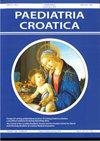Insights to biology and immunotherapy of osteosarcoma
Q4 Medicine
引用次数: 0
Abstract
Osteosarcoma is the most common primary tumor of the bone with the highest incidence in the first two decades of life. The incidence rate with 95% confidence is 4 for the range of 0-14 and 5 for the range of 0-19 cases pre million per year. Osteosarcoma is a rare malignant mesenchymal tumor with presence of mesenchymal cells and production of osteoid matrix (1). Distinct histological subtypes have been defined, but the biological behavior and the conventional approach to treatment have been similar for last couple of decades without improvement in outcome. The biology of osteosarcoma is characterized with a high rate of lung metastasis. Disorganized genome seems to be the best description of genetic aberrations and changes in gene expression in osteosarcoma, with the most consistent finding, beside the p53 and RB dysregulation,significant aneuploidy and some evidence of massive disruption in the chromosomal structure (2). The metastatic cascade represents a process where cell leaves primary tumor and invades the surrounding tumormicroenvironment with intravascular and also extravascular invasion to the distant sites enabling the blood supply and growth to the secondary site and reengage to the new microenvironment. Meanwhile, metastaticcell could be dormant in the „protective“ environment and then move to the secondary distant sites (3). The microscopic metastases are usually responsible for disease progression, so targeting geneticand epigenetic alterations will certainly improve the outcome (2). Recent studies showed that metastatic clones often do not correspond to the dominant clones in the primary tumor, but may evolve monoclonal and polyclonal, showing the clonal/subclonal heterogeneity of osteosarcoma. At the same time, immune response is a complex process that combines recognition of tumor cells, and response of effector and regulatory immune cells. Tumor cells by soluble factors secretion lead to downmodulation of the immune system. The well known immune „escape“ is the hallmark of cancer when immune system play a dual function, slowing down the tumor progression at first and then facilitating the tumor growth after the modelling phase of tumor cells. How to switch immunotolerance which contribute to permissive microenvironment beneficial for tumor cells to immunocompetent environment, is the challenge of immunotherapy (4). Two mains immunotherapeutic approaches are proposed for bone sarcomas. The first one is based on targeting the pro-tumoral effectors including M2 macrophages, i.e. muramyl tripeptide phosphatidylethanolamine (MTP-PE), interferon gamma (IFNγ) and the molecules associated with immune checkpoints; programmed death-ligand 1 (PD-L1) with it's receptor, programmed cell death protein (PD1) and cytotoxic T-lymphocyte-associated antigen 4 (CTLA-4). The other one is based on the stimulation of anti-tumoral effectors; dendritic cells (DC), nitrogen containing bisphosphonates (N-BPs) and natural killer cells (NK). MTP-PE is a drug registered by European Medicinal Agency (EMA) for postoperative treatment of high-grade osteosarcoma. Recently, we have started to apply MTP-PE in Croatia, and in time, we will see the results. The concept of chimeric antigen receptor (CAR) T-lymphocytes (CAR T-cells) has been developed to bypass the human leukocyte antigen restrictions, so diverse CAR T-cells have been developed based on this concept (CAR T-cells targeting B7-H3) (5). The SARC028 clinical trial revealed an interesting clinical response which highlight a major difference between adult and pediatric cancers that may be explained by low expression of neoantigens in addition to their specific microenvironment. Attenuated oncolytic viruses inoculated directly into tumor mass or delivered by macrophages have been proposed as one of the options also. However, the low immunogenicity of pediatric tumors will require other approaches with full molecular profiling of all bone sarcomas. This is mandatory in order to establish targetable biomarkers for better identification and selection of patients for specific therapies.对骨肉瘤生物学和免疫疗法的见解
骨肉瘤是最常见的原发性骨肿瘤,在生命的头二十年发病率最高。发病率(95% 置信度)为每年 0-14 例为 4 例,0-19 例为 5 例。骨肉瘤是一种罕见的恶性间质肿瘤,存在间质细胞并产生类骨基质(1)。目前已确定了不同的组织学亚型,但其生物学行为和常规治疗方法在过去几十年中一直相似,且疗效未见改善。骨肉瘤的生物学特点是肺转移率高。基因组紊乱似乎是对骨肉瘤基因畸变和基因表达变化的最佳描述,除 p53 和 RB 失调外,最一致的发现是显著的非整倍体和一些染色体结构大规模破坏的证据(2)。转移级联是指细胞离开原发肿瘤,以血管内和血管外的方式侵入周围的肿瘤微环境,使血液供应和生长得以向远处转移,并重新进入新的微环境的过程。 同时,转移细胞可能在 "保护 "环境中休眠,然后转移到远处的次要部位(3)。微小转移灶通常是疾病进展的罪魁祸首,因此针对基因和表观遗传学改变的靶向治疗必将改善疗效(2)。最近的研究表明,转移瘤的克隆往往与原发肿瘤中的优势克隆不一致,而可能演变为单克隆和多克隆,显示了骨肉瘤的克隆/亚克隆异质性。同时,免疫反应是一个复杂的过程,既包括对肿瘤细胞的识别,也包括效应免疫细胞和调节免疫细胞的反应。肿瘤细胞通过分泌可溶性因子导致免疫系统的下调。众所周知,免疫 "逃逸 "是癌症的特征,此时免疫系统发挥着双重作用,一开始会减缓肿瘤的发展,而在肿瘤细胞的模塑期过后,免疫系统又会促进肿瘤的生长。如何将造成有利于肿瘤细胞的微环境的免疫耐受转变为免疫无能环境,是免疫疗法面临的挑战(4)。针对骨肉瘤提出了两种主要的免疫治疗方法。第一种是针对促肿瘤效应因子,包括 M2 巨噬细胞,即氨甲酰三肽磷脂酰乙醇胺(MTP-PE)、γ 干扰素(IFNγ)和与免疫检查点相关的分子;程序性死亡配体 1(PD-L1)及其受体、程序性细胞死亡蛋白(PD1)和细胞毒性 T 淋巴细胞相关抗原 4(CTLA-4)。另一种是基于刺激抗肿瘤效应因子:树突状细胞(DC)、含氮双膦酸盐(N-BPs)和自然杀伤细胞(NK)。MTP-PE 是一种经欧洲药品管理局(EMA)注册的药物,用于高级别骨肉瘤的术后治疗。最近,我们开始在克罗地亚应用MTP-PE,假以时日,我们将看到它的效果。嵌合抗原受体(CAR)T淋巴细胞(CAR T细胞)的概念是为了绕过人类白细胞抗原的限制而提出的,因此基于这一概念开发出了多种CAR T细胞(靶向B7-H3的CAR T细胞)(5)。SARC028 临床试验揭示了一种有趣的临床反应,凸显了成人癌症和儿童癌症之间的重大差异,这可能是由于新抗原的低表达以及特定的微环境造成的。 将减毒的溶瘤病毒直接接种到肿瘤组织或通过巨噬细胞递送也被认为是一种选择。然而,由于小儿肿瘤的免疫原性较低,因此需要采用其他方法,对所有骨肉瘤进行全面的分子分析。为了更好地识别和选择接受特定疗法的患者,必须建立有针对性的生物标志物。
本文章由计算机程序翻译,如有差异,请以英文原文为准。
求助全文
约1分钟内获得全文
求助全文
来源期刊

Paediatria Croatica
医学-小儿科
CiteScore
0.20
自引率
0.00%
发文量
0
审稿时长
6-12 weeks
期刊介绍:
In the inaugural 1956 issue of the journal, the editor Dr Feđa Fischer Sartorius outlined the journal''s vision and objectives saying that the journal will publish original papers on the development, pathology, and health care of children from the prenatal period to their final biological, emotional and social maturity. The journal continues this vision by publishing original research articles, clinical and laboratory observations, case reports and reviews of medical progress in pediatrics and child health.
 求助内容:
求助内容: 应助结果提醒方式:
应助结果提醒方式:


